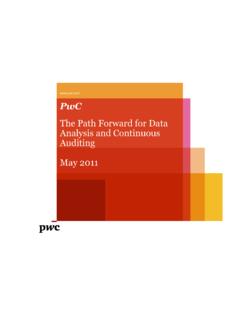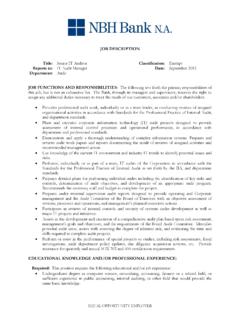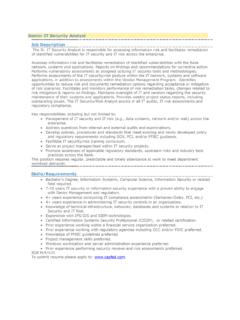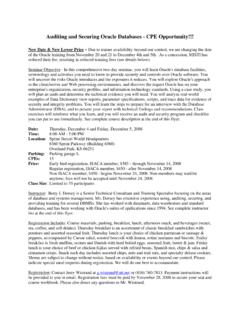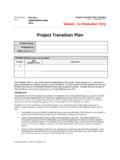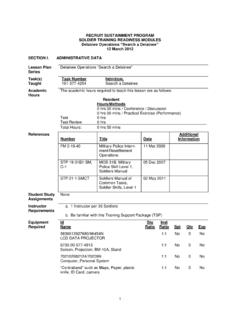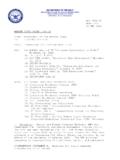Transcription of www.pwc.com Adding Strategic Value with Project …
1 Adding Strategic Value with Project Assurance PwC Welcome and Introduction 2 PwC Vicki Wagoner Internal Audit Services 3 PwC Anthony Canning IT and Project Assurance 4 PwC Today s Agenda Becoming Relevant Historical Perspectives Taking Action Project Delivery 5 PwC Becoming Relevant: Stakeholders Perspective on Internal Audit 6 PwC Stakeholders Perspectives on the Future of Internal Audit Strategic Alignment of Internal Audit s Plan Focus should be on processes that are critical to shareholder Value Scope should be directly linked to the organization s Strategic themes and critical processes Resources prioritized toward projects with potential for greatest impact The focus of internal audit, controls & compliance organizations should evolve and align with emerging / changing risks: Strategic & Business 60% Financial 15% Operational 20% Compliance 5% 7 PwC Becoming Relevant: Corporate Strategies 8 PwC Growth and Risk are Back in the Spotlight 9 Confidence levels are rising across the board, with 51% of global CEOs very confident of growth prospects over the next 3 years.
2 Just two years after the depths of the worst economic crisis in 75 years, CEOs have a strong but cautious optimism. PwC Continues to be a Significant Investment in IT Across Industries 10 IT is a key enabler of many growth initiatives In midst of significant ERP upgrade cycle for key vendors Opportunities to leverage IT to reduce costs (shared service, cloud, etc.) Projects are increasingly complex, frequently requiring collaboration across geographies and organizations Management is questioning current Value from their systems investments - increased focus on delivery of business benefits PwC Polling Question show of hands Does your organization have ERP / systems based projects going on now? Are you involved in some capacity? 11 ? PwC Historical Perspectives: Do Projects Deliver? 12 PwC Do Significant Organizational Projects Deliver? 13 Projects that go live, but lose up to one quarter of planned benefits Projects which don t meet all criteria for success ERP implementations viewed as business failures ERP projects that don t meet the expectations of senior management Statistical chances of an $10m+ ERP Project not coming in on time and on budget ERP implementation projects that are not completed 84% 86% 51% 71% 100% 20%+ PwC Reasons Projects Fail 14 0 5 10 15 20 25 30 35 40 Total of cases 1st reason 2nd reason From PwC Survey Boosting Business Performance through Program and Project Management Bad estimates/ Missed deadlines Change in environment Change in strategy Insufficient budget Insufficient support Insufficient motivation Poor quality of deliverables Scope changes Insufficient resources Imprecise goals Poor communication Wrong Project mgmt Stakeholders not adequately defined PwC Historical Perspectives.
3 Impact of Projects on the Control Environment Seven Sins of Implementations 15 PwC Seven Sins of Implementations 16 Automated Controls Locking Down of Bypass Controls System Generated Reports Data Conversion / Interfaces User Access Standard and Company Defined Super-user Accounts Organizational Change Management 1 2 3 4 5 6 7 PwC 1. Automated Controls Common Observations: documentation identifies minimal key automated controls inherent controls recognized in the documentation. to recognize that implementation carries a new controls landscape Questions to Consider: internal controls (business and IT) over financial reporting been contemplated and incorporated in the process design? end users been adequately trained on how to perform their job and execute controls upon go-live? there potential to leverage automated controls to reduce manual controls? 17 PwC 2. Bypass* Controls Common Observations: Automated controls may be bypassed; the most common ways are: 1.
4 Configuration not finalized: -Linking of purchase requisitions to POs -Workflow did not include all transaction types. Redundant system functionality not locked down. Questions to Consider: were controls and bypass documented during the design phase? was the overall UAT approach? users leveraging the roles they will have in production during the UAT testing? *Bypass is where a key system control can be compromised 18 PwC 3. System Generated Reports Common Observations: all key custom or standard reports used are identified in SOX documentation. goes live when key reports are not available. in obtaining results of report testing. of adherence to documentation standards. Questions to Consider: can you confirm that reports are complete & accurate? you identify your Key report inventory early? you leverage UAT of reports for Audit purposes? 19 PwC 4. Data Conversion/Interfaces Common Observations: high level diagram showing interaction between new system and other systems.
5 Of documentation of Functional / Technical Design Specifications. plans and results are not well documented / are not comprehensive. reconciliation controls not consistently detailed in documentation. are not stress tested / cannot handle the volume of traffic in the production environment (including errors with legacy systems). Questions to Consider: data is being converted? is it being converted? much is being converted? are data transmissions complete and accurate? 20 PwC 5. User Access Common Observations: different security design implemented than that which was originally outlined. of Duty conflicts in underlying profiles / roles which are used to build user access rights. time for handover by integrator / insufficiently trained client staff on security administration. Questions to Consider: was the approach for designing responsibilities? did you ensure appropriate segregation of duties prior to go-live?
6 The system administration team reduced upon go-live? consultants with sensitive access been removed from the system? 21 PwC 6. Super Users Common Observations: members having access to live environment to provide hypercare or support rollout of new sites / functionality. profiles not well defined and allocated to too many users. department having access to functional modules through widely defined profiles. accounts not sufficiently restricted and monitored. Questions to Consider: was the approach for designing responsibilities? did you ensure appropriate segregation of duties prior to go-live? the system administration team reduced upon go-live? consultants with sensitive access been removed from the system? 22 PwC 7. Organizational Change Management Common Observations: not clear on how to operate the system. still being trained after implementation. rights not set-up or not all required users set up.
7 Increase in number calls to the help desk in after go-live; themes are: a) Access issues; b) Training; c) Workflow; and d) Use of system Integrator does not properly hand-over knowledge and experience to the personnel responsible for operating the system in the production environment. Questions to Consider: processes appropriately designed to meet the business requirements: Approval of functional design documents. Approval of configuration design documents. Technical design documents meet those requirements. there change control processes that manage business requirement and design updates. 23 PwC Taking Action: Stakeholders & Risk 24 PwC Project Stakeholder Interests 25 Stakeholder Typical Concerns Potential Value Proposition Audit Committee Delivery of anticipated benefits Accuracy of status reporting and oversight Impact on existing internal control environment Benefits realization, regulatory and control impacts, status validation Project Sponsor Delivery of anticipated benefits Communication with various stakeholders Organizational readiness Benefits realization, organizational readiness, expected outcomes assessment Project Manager Project governance model Issue communication and resolution PMO effectiveness Project governance model, issues escalation, PMO procedures, end user expectations Function Lead or End User Readiness of the user community Efficiency/Effectiveness of the solution Issue communication and resolution Controls assessments, organizational readiness.
8 Issue escalation Internal Audit Knowledge transfer Impact on existing financial, operational and regulatory controls Training and knowledge transfer, controls assessments External Audit Tone at the top and company level controls Impact on financial controls Data conversion and program development Financial controls assessment, control environment, program development processes, data conversion (pre-imp) PwC Risk Considerations 26 Project Risk Controls Risk Business Risk Project Management Project Governance Functional Readiness Technical Readiness Organizational Readiness Business Case Benefits Realization Plan Benefits Ownership Data Quality Interfaces ITGCs Business Processes Company Implementation methodology Business Risk: Have expected business benefits been clearly defined and communicated? Project Risk: Will the solution be delivered on time, on budget, and to specifications? Controls Risk: Will the design and implementation of controls satisfy financial reporting, operational and regulatory requirements in an efficient and effective manner?
9 PwC Project & Business Risks: Driving Constructive & Forward Looking Conversations 27 6 pillars of Project success Risks are managed Scope is realistic & managed Stakeholders are committed Work & Schedule are predictable Business benefits are realised Team is high performing Risk management process Risk identification, management and escalation procedures Documentation and audit trails Monitoring and reporting Scope risk Clear & agreed scope Scope change control Dependency management Implementation timing Stakeholder risk Project governance & stakeholder buy-in Supplier management Communication internal and external Organisational change management Team risk Project organisation Resourcing skills and numbers Team mobilisation & succession Benefits risk Business case and ownership Measurement, baseline and KPIs Cost tracking Benefits tracking and reporting Schedule risk Project and workstream planning Progress monitoring and reporting Project control processes Quality assurance process PwC Project Lifecycle 28 MaintainImplementation SupportDeliverBuild & TestDesignDefineBusiness CaseBenefits Realization Business ProcessesIT General ControlsData QualityInterfacesTechnical ReadinessOrganization ReadinessFunctional ReadinessProject Outcomes - EnvironmentProject Outcomes - LifecycleControls OutcomesBusiness RequirementsTechnical RequirementsOrganization Change AssessmentProcess DesignSoftware/Hardware DesignOrganization DesignUnit/Integration TestingPerformance TestingUser Acceptance Testing (UAT)
10 & TrainingProcess CutoverHardware CutoverTraining DeploymentProcess Validation/Workaround UpdatesPerformance RefinementUser SupportProcess MaintenanceTechnical Upgrades/MaintenanceOngoing User Support and TrainingBusiness OutcomesBusiness Process Control RequirementsBusiness Process Control DesignITGC Control DesignDataRequirementsInterface RequirementsData MappingInterface DesignControl TestingTest/QA Environments Data Conversion TestInterface TestingControl MigrationProduction Environment Data Conversion ValidationInterface ValidationTransition Support/WorkaroundsTemporary IT Transition SupportApproved Business CaseBusiness Case Validation - DesignMetrics DefinedBusiness Case Validation Build Metrics ValidationBusiness Case Validation - MigrateMetrics Mgt Processes ImplementedCollect Preliminary MetricsProcess Monitoring and MaintenanceIT Monitoring and MaintenanceData Monitoring & MaintenanceInterface Monitoring & MaintenanceContinuous Metrics MonitoringProject Management Processes Project Governance TestingConsiderationsImplementationConsi derationsTest StrategyTest PlansImplementation RequirementsTest Scripts and ResutlsCutover PlanUser ValidationCutover ResultsITGC Control RequirementsMetrics ConsiderationBenefits OwnershipOwners DefinedOwners Committed Owners Trained Metrics ValidatedOwners AccountableOwners AccountableInterface Transition SupportData Transition SupportPwC Audit & Assurance Alternatives 29 Design Construct Implement Operate and Review Structure Process Technology People Change Strategy Target business model review Process and controls review Sourcing review Service/ Business as Usual health check Go-live programme health check Programme health check Programme health check Programme Initiation review Programme health check Target architecture and application review People and organisation impact review Change
